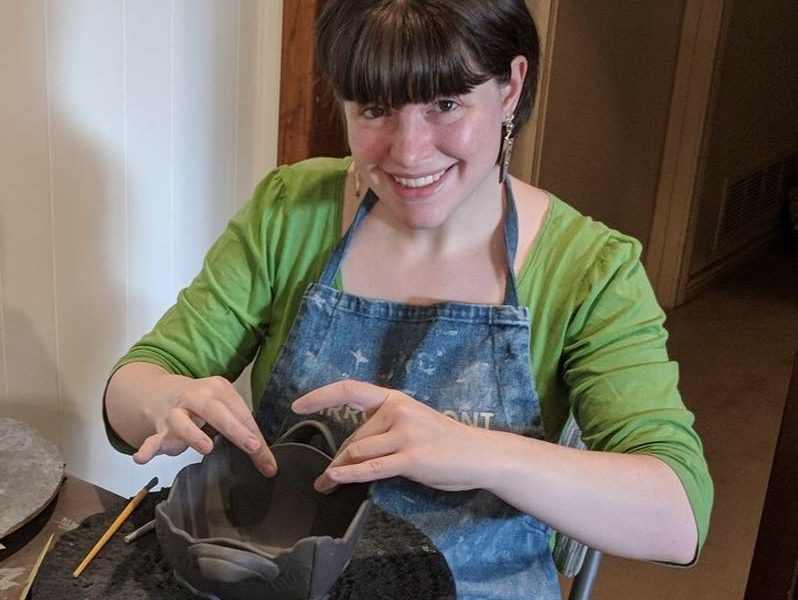

Today we’d like to introduce you to Amy Henson.
Thanks for sharing your story with us Amy. So, let’s start at the beginning and we can move on from there.
I always had an attraction to art, insofar as I can remember. My parents lovingly supplied my childhood with craft dough and crayons to my heart’s content. I remember as a middle school child, I would put a CD in and start a drawing I planned to spend all day on. Eventually, I realized it was the thing in my life I most enjoyed and would be happiest to establish a business making art, so I became determined to pursue a degree in studio art. Although I arrived at Southern Methodist University thinking I would focus on painting, the university program required classes in various other media which is something they termed distribution. I took a beginning class in wheel throwing pottery to meet this requirement. I was seduced by the complex challenge of making a functional pot with the craftsmanship and self-critique needed to help it become an art object. After the end of semester critique, my ceramics professor Peter Beasecker suggested that I consider changing my concentration, which was the little push I needed. I completed my BFA in studio art concentrating on ceramics.
For seven years after graduation, I pursued a body of work made with porcelain clay thrown on the wheel, fired to a high temperature in pottery kilns that combusted washing soda or salt to create a beautifully variegated atmospheric surface. In 2014, I took a workshop with a ceramic artist named Margaret Bohls demonstrating a type of hand building off of the wheel with flat panels of clay, called slab building. I had been feeling stymied by wheel throwing because I always altered the pots off round and thrown clay has memory so it resisted being taken away from roundness. The hand-building opened up a whole new world for me, one in which I could make any shape I desired with clay that had no structural attachments to resist. I wanted a fresh start in my studio so I committed to making slab-built pottery. Perhaps, the long tradition of woman potters back into antiquity reached out of my Jungian subconscious because much of the coil, slab, or pinch built pottery of prehistory was the work of female artisans. I’m about four years into my hand building journey and enjoying every minute of it!
Has it been a smooth road?
There’s nothing about being a studio artist that could qualify as being called a smooth road, in my opinion anyway. Trying to balance life with art and figure out whether something you make is successful, or if patrons will purchase it, or where to go next in the studio is always a struggle. It definitely took some serious re-balancing to keep making work after I gave birth to my daughter, who is now nearing four years old. I also struggle with imposter syndrome when I achieve a lofty goal or accolade and self-doubt when my feedback is negative or in the face of rejection. Fortunately, making pots has a way of constantly putting failure in my path to keep me loose and capable of rolling with difficulty. I also know the importance of putting oneself out there for juried opportunities like gallery shows, because if an artist doesn’t aim for professional success and credibility then they’ve already failed. There are always jurors and opportunities that reply “yes” even if it takes a lot of attempts.
So let’s switch gears a bit and go into the Alazan Ceramics story. Tell us more about the business.
One of the wonderful things about clay and ceramic artists is the infinite potential because each artist’s individuality will end up differentiating their work. I capitalize on that potential by plumbing the depths of my own interests and aesthetic preferences. Making pottery means getting a practical function to integrate with artistic vision, so I’ve had to learn to be a designer and a craftsman just as much as an image maker. I love getting an elegant spout to pour crisply, or a lid that fits with no wiggle room, or a lovely mug handle that feels just right. In fact, many of my favorite objects to develop are what I call analog gadgets, things which specialize in particular tasks like ring stands, spaghetti jars, citrus juicers, berry bowls, garlic graters, and fermentation crocks. The real value of a specialized object like this lies in the way it emphasizes ceremony and beauty in everyday mundane activities like eating, drinking, storing jewelry, and the like. All functional pots enrich the acts of self-care and nourishment in the same manner but I enjoy turning this quality up to eleven, so to speak.
I adore old world craftsmanship and vintage garments and kitchenware, which definitely has a strong influence on what I make. I grew up carefully sorting my grandmother’s jewelry armoire and fingering the antique gowns in her closet, sitting around a Thanksgiving table full of cut crystal or baking with 1960’s Pyrex. The goal is to translate those sensations into my pots. The visceral comments I get from people when they first see my work often reflect that it’s coming through, with common descriptors including “whimsical” and “retro.”
I’ve also been working with a lot of imagery related to the hidden or overlooked elements of the environment I live in combined with themes related to endangered species and climate change, subjects like skunks, ocelots, drought, and roadkill. I recognize that not everyone has a consensus of whether or not humans have negatively influenced global climate. I do wholeheartedly believe that when people slow down, get in touch with their appreciation of the plants and animals around them, and try to live with an eye towards good stewardship of our natural resources, it can only yield beneficial results.
How do you think the industry will change over the next decade?
Pottery is one of humanity’s oldest forms of expression, so it’s definitely not going away. There are a lot of new and exciting opportunities and technology from industry, like 3-d printing and self-firing kilns. Ceramic artists are always looking for different colorants, clay, and surfaces, and some relatively new innovations include the use of rare earth elements like neodymium, which creates a magical color-changing glaze that morphs from blue to purple in a different light. Ceramic artists will continue to find something fresh and exciting looking at pottery from world history since an enormous wealth of source material with extraordinary durability exists. The recent popularity of concepts like farm to the table have brought pottery to the fore as a relevant art form in United States culture, so I expect to see many new voices emerge as the amateur talents progress.
Pricing:
- Mug $55
- Tumbler $48
- Garlic Grater $25
- Citrus Juicer $80
- Berry Bowl $80
Contact Info:
- Website: http://www.alazanceramics.com
- Email: hensonamy84@gmail.com
- Instagram: https://www.instagram.com/alazan_ceramics/
- Facebook: https://www.facebook.com/AlazanCeramics/








Getting in touch: VoyageDallas is built on recommendations from the community; it’s how we uncover hidden gems, so if you know someone who deserves recognition please let us know here.

















